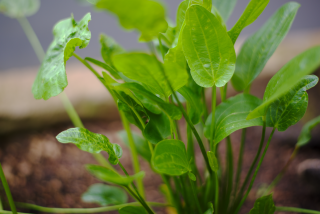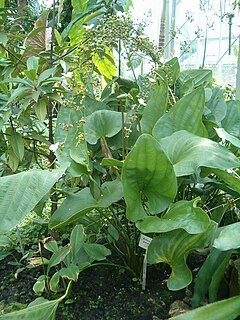
Milla, the Mexican star, is a genus of monocotyledonous plants in the family Asparagaceae, subfamily Brodiaeoideae. They are native mostly to Mexico, with one species extending into Guatemala, Honduras, Arizona, Texas and New Mexico.

Echinodorus, commonly known as burhead or Amazon sword, is a genus of plants in the family Alismataceae, native to the Western Hemisphere from the central United States to Argentina. Its scientific name is derived from Ancient Greek echius – "rough husk" - and doros – "leathern bottle" - alluding to ovaries, which in some species are armed with persistent styles, forming prickly head of fruit. Some of the species are commonly cultivated in artificial aquatic habitats.
Echinodorus horizontalis is a species of plants in the Alismataceae. It is native to northern South America.
Echinodorus tunicatus is a species of aquatic plants in the family Alismataceae.
Echinodorus longiscapus is a perennial, aquatic plant of the Alismataceae, native to South America. It is cultivated as a pond or aquarium plant.

Echinodorus macrophyllus is a species of aquatic plants in the Alismataceae. It is native to Brazil and Bolivia.

In Rataj's taxonomy Echinodorus ovalis is in Section Cordifolii, Subgenus Echinodorus. It is related to Echinodorus cordifolius and listed by some authorities and importers as a synonym of that species, e.g. E. cordifolius 'ovalis'.
Echinodorus trialatus is a type of plant. In Rataj's taxonomy, E. trialatus is in Section Paniculati, Subgenus Echinodorus.

Echinodorus uruguayensis or Echinodorus osiris is a plant species in the Alismataceae. It is native to South America.

Echinodorus berteroi is an aquatic plant species in the Alismataceae It is native to the southern and central parts of the United States, as well as Central America, the West Indies, and South America as far south as Argentina.
Echinodorus bracteatus is a species of plants in the Alismataceae. It is native to Costa Rica, Nicaragua, Panama, Colombia and Ecuador.

Echinodorus grandiflorus is a plant species in the Alismataceae. It is native to Brazil, Paraguay, Uruguay, Argentina, Venezuela and Florida.

Androlepis skinneri is a plant species native to southern Mexico and Central America. This is one of the few Bromelioideae species that is dioecious.
Billbergia viridiflora is a plant species in the genus Billbergia native to Tabasco, Belize and Guatemala.

Tillandsia ionantha, the air plant, is a species in the genus Tillandsia. This species is native to Central America and Mexico. It is also reportedly naturalized in Broward County, Florida.

Pitcairnia wendlandii is a flowering plant in the Bromeliaceae family. It is native to Costa Rica, Panama, Honduras, Guatemala and Chiapas.

Yucca aloifolia is the type species for the genus Yucca. Common names include aloe yucca, dagger plant, and Spanish bayonet. It grows in sandy soils, especially on sand dunes along the coast.
Albidella is a genus of plants in the Alismataceae. At the present time, only one species is known, Albidella nymphaeifolia, formerly called Echinodorus nymphaeifolius. It is native to Cuba and the Yucatán Peninsula.

Helanthium tenellum, the pygmy chain sword, is a species of plants in the Alismataceae. It is native to the eastern United States, southern Mexico, West Indies, Central America, South America

Echinodorus grisebachii or Echinodorus amazonicus is commonly known as Amazon sword plant, although other plants are also known under this common name. The aquatic plant is cultivated for and used in ponds and artificial aquatic habitats. It is native to Cuba, Central America, and South America as far south as Brazil and Bolivia.













